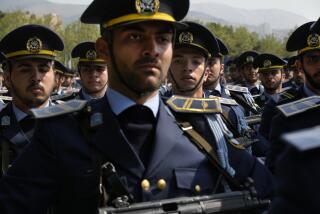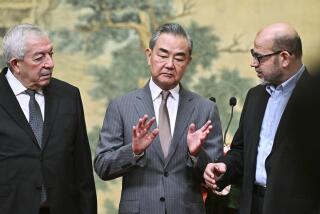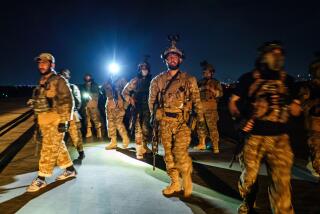Long-Divided Afghan Rebels Form Alliance
- Share via
PESHAWAR, Pakistan — Since the Soviet invasion of Afghanistan in 1979, disunity and internecine conflicts have plagued the resistance forces, hobbling their effort against the Soviet army and Afghan government troops.
But now the moujahedeen rebel leaders hope that an alliance formed in this Afghan frontier city earlier this month will lead to greater cooperation between moderate and fundamentalist factions.
The hope is shared by the U.S., Chinese and Saudi Arabian governments, which are expected to provide the rebels--under covert aid programs--with more than $400 million in military equipment this year.
The alliance, called the Ittehade Islami Afghan Moujahedeen, is made up from the seven largest, most active resistance organizations. It is the first time that all the leaders of the major groups, which range from Muslim purists on the Iranian model to Western-style secularists, have sat down together in a shoora , or ruling council.
“Never before have all gathered,” said Farouk Azam, a senior leader in the moderate National Islamic Front.
Surgul Speen, a spokesman for the rabidly fundamentalist Islamic Party, said: “It is one of the most important actions taken in the past seven years. Before this, no one could . . . speak for the Afghan moujahedeen.”
One of the main purposes of the alliance is to choose a single spokesman from among the seven leaders to represent the resistance in international forums, something that has been embarrassingly lacking over the last five years of war.
There are at least 37 organized rebel groups fighting to topple the Soviet-installed regime of President Babrak Karmal in the Afghan capital of Kabul. They include royalists fighting for the return of King Mohammed Zahir Shah, who is in exile in Rome; Maoists; Persian-speaking Shia Muslims, and obscure Sufi sects. They represent dozens of tribes in remote, rugged regions, and they speak dozens of languages and dialects.
No One Spokesman
So far, at least, no one person has been able to speak for their cause: the overthrow of the Soviet-backed regime of Babrak Karmal and the withdrawal of the estimated 120,000 Soviet soldiers in Afghanistan.
“There is no Afghan equivalent of the Palestine Liberation Organization,” British journalist Edward Mortimer has written--”no Afghan Yasser Arafat to appear as ‘Mr. Afghanistan’ on the front pages and TV screens of the Western world.”
This lack of a highly visible dominant figure has worked against the resistance movement in its pursuit of funds and equipment.
Barhauddin Majrooh, director of the Afghan Information Center, said: “It got so every leader was going to the United States . . . and holding press conferences. It was very awkward.”
On occasion, the competition for money and attention led to violence between rival groups. Last summer, the Pakistani government ordered the various rebel organizations to move their offices outside the central business area of Peshawar, this dusty city in the North-West Frontier province where most of them were headquartered. The order was issued after a bomb thought to have been planted by one group of resistance fighters exploded outside the office of the Islamic Party, killing four people.
More conflicts were reported inside Afghanistan. A prominent rebel leader near the southwestern city of Kandahar recently defected to the Communist government after losing his territory to a rival organization in a series of armed battles. In many cases, Afghan leaders say, the conflicts are sparked by agents of the Soviets and the Afghan government.
In the face of an expanded Soviet offensive in Afghanistan, which this year for the first time did not relax in the winter months, Afghan leaders and Western diplomatic sources say there have been fewer cases of internecine fighting and that field commanders are pushing for more united leadership from their Peshawar-based organizations.
‘Russians Will Run Away’
“The moujahedeen fighters have been feeling so unhappy because of these divisions,” Rasul Tarshi of the fundamentalist Islamic Society said. “I can tell you that once this unity is achieved, the Russians will run away, leaving their weapons behind.”
There are, of course, other potential benefits to having a movement under one banner. The leaders of the seven major groups hope that the other, smaller groups will come into the fold, although not as members of the ruling council.
According to Gulbaddin Hekmatyar, leader of the Islamic Party, who announced the alliance at a news conference here last week, the alliance will have military and logistical advantages in addition to the obvious public relations benefits.
Hekmatyar said the moujahedeen will be able to consolidate and stockpile equipment.
“We should be able to simultaneously mobilize all our jihad (holy war) forces in a united front against the Russians inside Afghanistan,” he said.
Hekmatyar is one of four leaders in the ruling council who, according to political observers, could be chosen as spokesman for the movement, either on a permanent basis or as the first in a series of rotating spokesmen. He is considered one of the least palatable to the United States, which is philosophically more attuned to the moderate leaders.
Hekmatyar’s offices are adorned with posters showing President Reagan as a villain along with the Soviet leaders. His party is known for its close affinity to the Iranian fundamentalists. Hekmatyar rallies often feature chants of “Death to Reagan” as well as “Death to Gorbachev.”
Western diplomats, who have hoped for unification of the rebels to help control aid programs and keep track of the money spent here, are skeptical that the alliance will last.
“It could be significant,” one said. “It will probably allow them to have a central spokesman. That in itself would be a giant step forward. But if all this turns out to be some kind of vague body put together for public consumption only, then I don’t think it will make any difference.”
More to Read
Sign up for Essential California
The most important California stories and recommendations in your inbox every morning.
You may occasionally receive promotional content from the Los Angeles Times.













